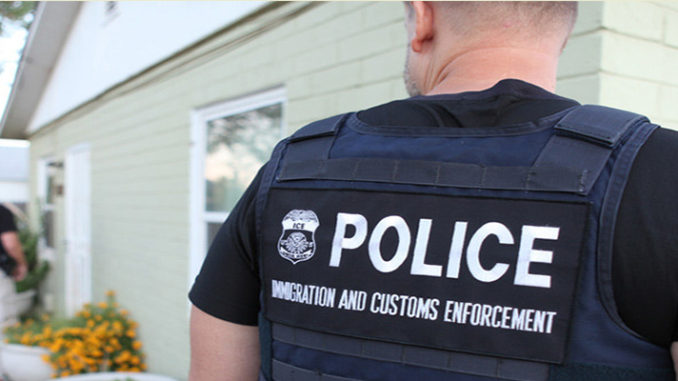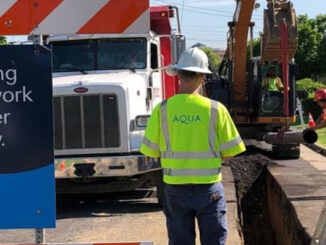
If the Trump administration follows through on its threat to deport thousands of immigrants living in the country illegally, it will start with migrants who are under removal orders signed by an immigration judge.
A Stateline analysis of immigration court data suggests that of the 1.1 million removal orders on file last month, 60% were issued to migrants residing in California, New York, Texas, Florida and Arizona.
Miami, Brooklyn, Los Angeles, Houston and Florence, Arizona, have the most removal orders, based on addresses listed in court documents, which can easily change. Many immigrants use the addresses of temporary detention centers, like the one in Florence, or homes of friends.
U.S. Immigration and Customs Enforcement (ICE) is planning to begin the raids Sunday, The New York Times reported.
In some cities and states where many migrants are under removal orders, immigrants, their advocates and some public officials are bracing for the threatened roundup and hoping legal assistance can stave off some deportations. In others, public officials say tougher enforcement is long overdue.
The leaders of many cities have condemned the administration’s deportation plan, including the mayors of Chicago, Los Angeles, New York and Newark.
Democratic Gov. Andrew Cuomo of New York last month vowed to “fight back at every turn to protect our immigrant families.” And Democratic Gov. Gavin Newsom of California told immigrants to “feel confident going to work, we have your back.”
Not so in Texas, where Republican Gov. Greg Abbott last month sent National Guard troops to help immigration authorities detain immigrants coming over the border.
Echoing President Donald Trump, Abbott has complained that Congress has refused to close loopholes that allow immigrants to cross the border requesting asylum. Arizona Republicans have expressed similar frustrations.
In Miami, Republican Mayor Francis Suarez has said he supports the deportation of violent criminals but hopes that law-abiding immigrants would not be disturbed by the raids.
“We agree that criminals, like dangerous gang members who came here illegally, should be deported immediately,” Suarez said in a statement. “I trust that only those individuals who represent a clear and present danger to our communities will be affected.”
Immigration hardliners say it doesn’t matter whether the immigrants in the country illegally are law-abiding or not.
“These immigrant scofflaws will no longer get a free pass from enforcement just because ICE has a lot of other things to do,” said Jessica Vaughan, director of policy studies for the Center for Immigration Studies.
Ira Mehlman, a spokesman for the Washington, D.C-based Federation for American Immigration Reform, which supports tougher immigration restrictions, said that “breaking immigration laws is sufficient to be deported. The IRS doesn’t give a break to tax cheats just because they didn’t rob a bank too.”
‘Millions of Illegal Aliens’
One June 17 Trump tweeted that “next week ICE will begin the process of removing the millions of illegal aliens who have illicitly found their way into the United States.” Several days later, Trump said he had delayed the raids for two weeks “at the request of Democrats.”
Senior ICE officials, who were surprised by Trump’s initial announcement, later said the raids would target thousands of migrants, rather than millions. But Kenneth Cuccinelli, the acting director of U.S. Citizenship and Immigration Services, said earlier this month that ICE was ready to “go and find and detain and then deport the approximately one million people who have final removal orders.”
Despite the administration’s rhetoric, immigration experts say a quick roundup of more than a million people would be all but impossible, since there are only a few thousand enforcement agents to identify and arrest them, and the number of spots in detention facilities is limited.
Instead, they suggested the threat and roundup of recent family arrivals is likely meant as a warning to discourage the wave of new immigrants crossing the border to claim asylum from violence in Central America, Africa and other parts of the world.
Matt Cameron, a Boston-area immigration attorney who represents many people who are under removal orders, said such migrants aren’t likely to be dissuaded.
“People really, really want to come here,” said Cameron, who founded the Golden Stairs Immigration Center. “This is all driven by the breakdown of civilized society in these countries run by criminal gangs.”
Those with removal orders already have been through court proceedings and either lost their cases or stopped showing up for hearings, said Sarah Pierce, a policy analyst at the nonpartisan, Washington, D.C.-based Migration Policy Institute.
“It is pretty easy to deport them,” Pierce said. “There’s very little the immigrant can do to fight it.”
Immigrants learn their fate through a “bag and baggage” letter from ICE. “They were supposed to show up with their bags packed and that didn’t happen, or they reentered after being deported,” Pierce said.
Cameron said it’s easy for an immigrant without legal representation to get a removal order just by not knowing how to check hearing dates.
He recalled a Brazilian family that came over the border seeking asylum. The family received a deportation order despite regular check-ins with ICE, because they missed a court date they didn’t even know about. About 1 in 5 removal orders is signed when immigrants fail to show up for court, records show.
“Generally, the people really want to go to court. I’ve never met anybody who just decided not to go,” Cameron said, adding that he was able to reopen the Brazilian family’s case and stop the deportation.
Many new immigrants in the Miami area, including Central Americans and Cubans who have crossed the Mexican border seeking asylum, have had trouble figuring out their court dates as the Trump administration speeds up processing, said Adonia Simpson, director of family defense for Americans for Immigrant Justice, a nonprofit legal clinic in Miami.
“There’s a lot of confusion. People have to call an 800 number and know their case number, and they have to do that frequently,” Simpson said. “There’s a big problem with representation. All the pro bono attorneys here are just inundated with calls and way over capacity.”
South Florida defense attorneys have formed a rapid response team and are planning a meeting Saturday to advise immigrants about their rights, Simpson said.
Offers of Legal Help
Some states and cities have offered immigrants legal services to avoid unnecessary removal orders, a strategy that appears to pay off, according to data from the Transactional Records Access Clearinghouse at Syracuse University.
In New York state, which along with New York City pays for legal representation for immigrants, 76% of immigrants facing deportation have a lawyer. Just 28% of cases in New York state result in a removal order — only Oregon has a lower rate.
New Mexico, Arizona and Louisiana have the highest rates of removal orders, at more than 70% of deportation cases, and representation rates of less than 26%.
Many cities have joined with nonprofits to help fund legal services for immigrants. One recent addition is Dallas, which has pledged $100,000 for the effort.
Almost 400,000 of those with removal orders are of Mexican origin, court records show. Another 210,000 are from the Central American nations of El Salvador, Guatemala and Honduras. And about 84,000 are from China.
The planned raids have roiled everybody in the immigrant community — not just those who are under removal orders, Cameron said.
“People with DACA, people with green cards are calling me up, asking if this affects them,” he said, referring to the Deferred Action for Childhood Arrivals program, which shields people brought to the United States illegally as children. “People with nothing to worry about are worried.”
Tim Henderson covers demographics for Pew Trust’s Stateline.



